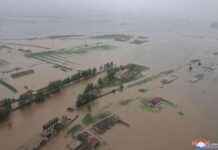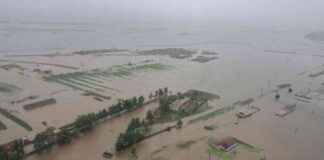Myanmar has been facing a devastating crisis as floods have claimed the lives of 74 individuals, with the number continuing to rise as search and rescue operations persist. The tragic situation has been exacerbated by heavy rains brought on by Typhoon Yagi, the most powerful storm to hit Asia this year. The aftermath of the storm has not only led to loss of lives but also widespread destruction, displacing thousands of people and leaving many missing.
Impact of the Floods
The flooding in Myanmar, which commenced last Monday, has ravaged several regions, including the capital Naypyidaw, Mandalay, Magway, Bago, as well as eastern and southern Shan state, Mon, Kayah, and Kayin states. Reports from the United Nations Office for the Coordination of Humanitarian Affairs (OCHA) indicate that central Myanmar has been the hardest hit, with numerous rivers and creeks overflowing from the Shan hills. This has resulted in widespread inundation, posing a significant challenge to ongoing rescue efforts.
Challenges and Obstacles
The situation in Myanmar has been compounded by the country’s existing turmoil following a military coup in February 2021. The violence and unrest that have plagued the nation have further complicated relief efforts, making it difficult for aid agencies to reach those in need. The International Committee of the Red Cross and other humanitarian organizations face access restrictions and security risks, limiting their ability to provide crucial assistance to affected communities.
Infrastructure and Humanitarian Concerns
The destruction caused by the floods extends beyond loss of lives and displacement. State media reports have highlighted the widespread damage to infrastructure, with five dams, four pagodas, and over 65,000 houses being destroyed in the wake of the disaster. The impact on essential services such as transportation, communication, and access to clean water has further exacerbated the humanitarian crisis, leaving millions of people in need of urgent assistance.
The challenges of collecting accurate information and assessing the full extent of the damage have been hampered by the damaged infrastructure and disrupted communication lines. Reports of additional casualties and landslides continue to emerge, underscoring the urgency of the situation and the need for swift and coordinated response efforts to prevent further loss of life and alleviate the suffering of those affected.
In conclusion, the devastating floods in Myanmar have claimed the lives of 74 individuals and left many more missing, with the death toll expected to rise as rescue operations continue. The impact of Typhoon Yagi has exacerbated the already dire situation in the country, further straining an already fragile infrastructure and complicating relief efforts. As Myanmar grapples with the aftermath of this natural disaster amidst ongoing political turmoil, the need for international support and solidarity is more critical than ever to ensure the safety and well-being of the affected population.




















